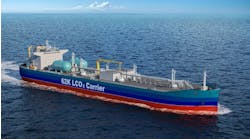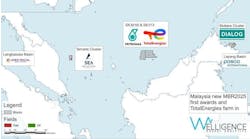Far East
KCA Deutag, a division of Abbot Group plc, announced that it has been awarded a detailed design contract with Hyundai Heavy Industries (HHI) for the Sakhalin-1 project in the Russian Far East.
The main contract for the drilling package fabrication has been awarded to HHI of South Korea.
KCA secured the sub-contract for the detailed design of the drilling facilities. The design project will be executed in Houston, Texas, followed by construction support and commissioning in South Korea.
The Sakhalin-1 project encompasses three offshore oil and gas fields in the Sea of Okhotsk. The project is being developed by a consortium of US, Russian, Japanese, and Indian companies and is operated by ExxonMobil affiliate Exxon Neftegas Ltd.
Mediterranean
Eni, through its subsidiary IEOC Exploration BV, has successfully drilled exploration well Tennin 1 offshore Egypt in the East Delta Deep marine exploration license.
The well was drilled at water depth of 300 m. Preliminary appraisal places Tennin reserves between 15 and 30 bcm of gas.
The Belayim Marine offshore field, found in 1961, was Egypt's first important offshore discovery and the one that enabled Egypt to become a major oil producing country. Exploration in the Nile Delta began in 1967, when the discovery of the Abu Madi gas field made Egypt a major gas producer. In 1996, 17 natural gas fields were discovered in the Nile Delta.
The East Delta Deep Marine exploration license is jointly owned by operator Eni and partner BP.
Middle East
The government of the Sultanate of Oman has announced that blocks 18A, 18B, and 41 in the Gulf of Oman will be licensed this year. The blocks cover a 45,240-sq-km area. The three blocks on offer were selected following interpretation of the new GO2002 2D survey acquired by PGS Geophysical AS. The survey comprises 5,839 line km with 2,738 additional line km of reprocessed data, available from water depths of 50-3,000 m.
41 in the Gulf of Oman will be licensed this year. The blocks cover a 45,240-sq-km area. The three blocks on offer were selected following interpretation of the new GO2002 2D survey acquired by PGS Geophysical AS. The survey comprises 5,839 line km with 2,738 additional line km of reprocessed data, available from water depths of 50-3,000 m. The licensing round opened Jan. 15 and is scheduled to close July 15.
Europe
The Druzhba-Adria pipeline integration project, initiated by Russia's Transneft, will create an export route to transport Russian and CIS countries' oil to world markets. Representatives of six east European countries signed an agreement in December 2002 to move forward with the project that will move oil through the deepwater port in Omishal, Croatia. Pipeline capacities will be gradually increased (5, 10, and 15 million metric tons/year). The route covers more than 3,000 km, passing through Russia, Byelorussia, Ukraine, Croatia, Hungry, and Slovakia. The pipeline is to be completed by 4Q 2004, Transneft said.
Connecting Adria with the Druzhba pipeline system will allow Russian oil to be transported directly to the Adriatic coast at a great cost savings. This is one of the most promising directions for the export of Russian oil, Russia's Yukos said. At present, oil is transported mostly by pipeline to the Black Sea (usually the Russian port of Novorossiysk), then loaded onto small tankers, which carry it through the Bosporus to Southern European ports on the Mediterranean.
Yukos said this route has some severe limitations. Forecasts indicate that up to 110 million metric tons of oil will be shipped through Black Sea ports by 2015. But the Bosporus – a narrow, winding strait that runs right through the center of Istanbul – will be able to handle no more than 90 million metric tons/yr.
Transportation and oil companies in Russia, Ukraine, Slovakia, Croatia, Kazakhstan, and Byelorussia are cooperating on this project.
Americas
Forest Oil Corp. has begun production from the Redoubt Shoal field in the Cook Inlet of Alaska. The field, which began producing Dec. 9, 2002, is producing in excess of 4,200 b/d from two of the four wells capable of production. Production is expected to be maintained near this rate until new onshore production facilities at Kustatan are completed. The production is currently flowing to Forest-owned facilities at the company's West McArthur River field.
Africa
ChevronTexaco's Angolan affiliate, Cab-inda Gulf Oil Co., has a ninth significant discovery in Angola's prolific deepwater block 14.
The Negage discovery is 29 mi southwest of the Gabela discovery, made in 2002, and was drilled in 4,738 ft of water.
Negage is the most recent in a series of block 14 discoveries, beginning with the Kuito discovery in 1997, which was followed by Landana, Benguela and Belize, Tomboco and Lobito, Tombua, and Gabela.
"Block 14 continues to be a tremendous asset for ChevronTexaco and its partners," said George Kirkland, president of ChevronTexaco Overseas Petroleum Inc.
Cabinda Gulf Oil Co. operates block 14 with 31% interest. Partners include Sonangol P&P with 20%, Agip Angola, Exploration B.V. with 20%, Total Angola with 20%, and Petrogal Exploration 9%.
Asia-Pacific
In early 2003, Reliance Industries Ltd. struck oil in the Krishna-Godavari basin off India. This discovery followed a significant gas find in December 2002 in the same area off India's east coast. In fact, Reliance has had a 100% success rate from the wells drilled in its Krishna-Godavari block.
Reliance is the only private sector Indian company that has made a discovery in India's offshore. From its first success, the company has vaulted into serious exploration.
Along with India's ONGC, Reliance was a major winner in the NELP-III licensing round concluded in 4Q 2002. Of the 23 blocks offered in the round, 22 went to Indian oil companies. In fact, there was very little foreign interest in the bidding round. With Reliance's successes, there could be significantly more foreign participation in NELP-IV. Reliance Industries, in conjunction with the UK's Hardy Oil and Gas, was awarded seven deepwater and two shallow-water blocks in NELP-III. Reliance, India's largest private sector E&P company, holds over 1,77,000 sq km of exploration acreage in 23 offshore and onshore blocks. Only 2,000 sq km of the total acreage has been explored to date.
While Reliance considers development options for its Krishna-Godavari field, the company has begun investing in additional acreage beyond that acquired in NELP-III. In late December 2002, Reliance purchased stakes in five offshore oil and natural gas exploration blocks, which it will operate in the Arabian Sea and the Bay of Bengal, from Ireland's Tullow Oil PLC.
This acquisition will help Reliance to solidify its position in the petroleum exploration and production business. As the Indian government moves to implement privatization of the state-owned companies, Reliance is securing a strong position in the country's growing E&P sector.
Central Asia
Activity in the Caspian Basin is set to get a boost from the US government. US State Department representatives met with oil and gas industry participants in New Orleans, Louisiana, Jan. 9 at the Caspian Basin Energy Conference to discuss working in the Caspian Sea. The federal government is promoting investment in the Caspian's oil and gas industry as part of its new energy policy, which focuses on securing energy sources outside the Middle East. That policy could mean good news for oil and gas companies.
Companies like BP have been active in the region for some time, primarily working on the Azeri-Chirag-Gunashli field. When phase three of the ACG development is in full swing, BP will spend $2 million/day drilling and will have up to eight rigs running at any time offshore Azerbaijan, according to BP's George Siler, vice president for ACG phase three full field development.
The incentive to work in Azerbaijan is significant. "There's lots of money. There's lots of opportunity," said Ross Wilson, American ambassador to the Republic of Azerbaijan. "The Azeri energy strategy is producing results," Wilson said. That fact, coupled with the region's possible and proven reserves of 33.2 Bbbl of oil and 39.4 tcf of gas, will encourage foreign investment.
Opportunities extend beyond Azerbaijan to the other littoral states, including Kazakhstan, where Parker Drilling has been operating for 10 years. Bob Parker, chairman of the board of Parker Drilling Co., said his company would continue to work in this challenging region for the foreseeable future. There are 10 to 20 more years of drilling to be done, Parker said.
According to Bill Veale, executive director of the US-Kazakhstan Business Association, Kazakhstan wants help developing its oil and gas industry and has shown "major interest in attracting foreign investment."
The other former soviet states in the region are also appealing. According to Ambassador Steven Mann, senior advisor for Caspian basin energy diplomacy, the largest production growth area in the world is the Caspian Sea. "You can operate profitably and with predictability," Mann said.
With the US push for diversity in energy sources, federal assistance could expedite development. In fact, that appears to be a primary State Department goal. "The foreign service is back," Mann said. There are now funds and people to provide advocacy for US businesses seeking opportunities in the Caspian.


